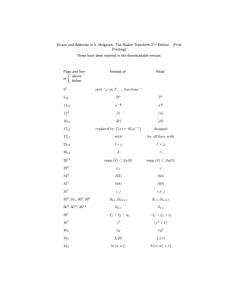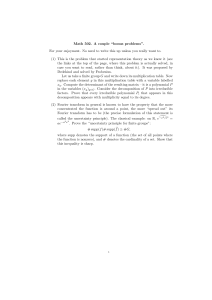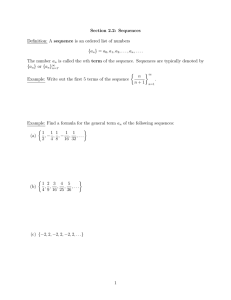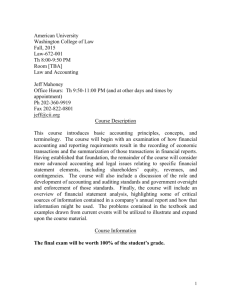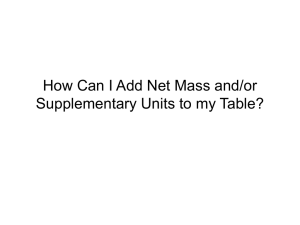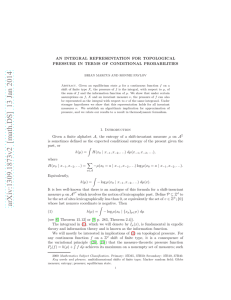Math 412: Problem Set 3 (due 29/1/2014) Practice
advertisement
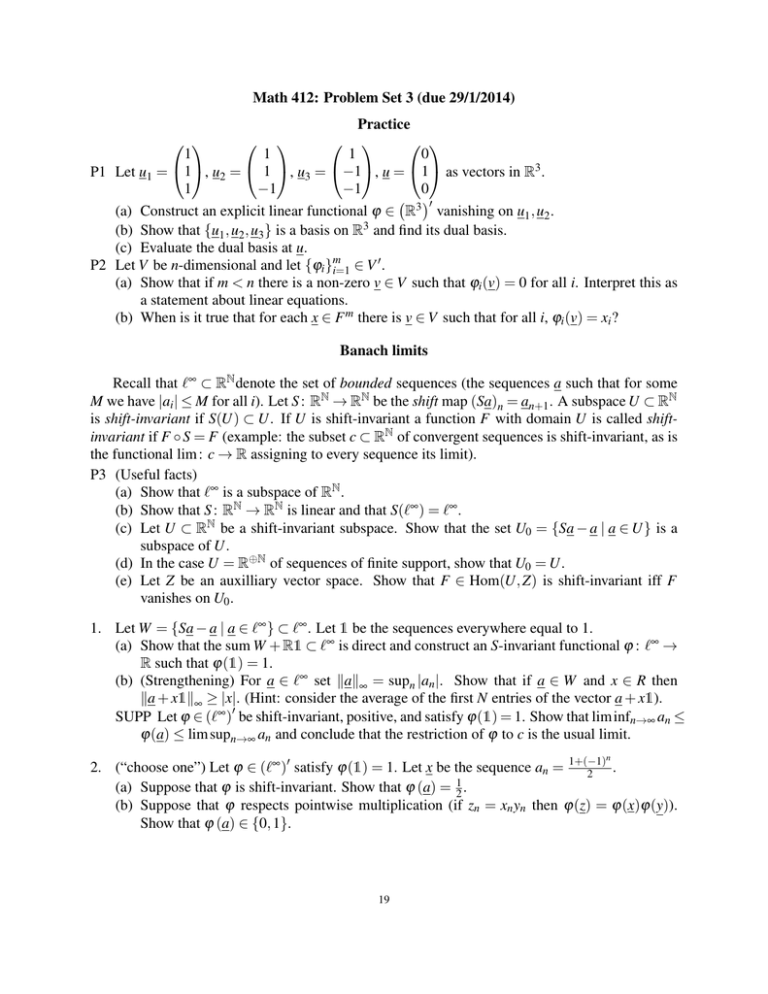
Math 412: Problem Set 3 (due 29/1/2014)
Practice
0
1
1
1
P1 Let u1 = 1 , u2 = 1 , u3 = −1 , u = 1 as vectors in R3 .
0
1
−1
−1
0
3
(a) Construct an explicit linear functional ϕ ∈ R vanishing on u1 , u2 .
(b) Show that {u1 , u2 , u3 } is a basis on R3 and find its dual basis.
(c) Evaluate the dual basis at u.
0
P2 Let V be n-dimensional and let {ϕi }m
i=1 ∈ V .
(a) Show that if m < n there is a non-zero v ∈ V such that ϕi (v) = 0 for all i. Interpret this as
a statement about linear equations.
(b) When is it true that for each x ∈ F m there is v ∈ V such that for all i, ϕi (v) = xi ?
Banach limits
Recall that `∞ ⊂ RN denote the set of bounded sequences (the sequences a such that for some
M we have |ai | ≤ M for all i). Let S : RN → RN be the shift map (Sa)n = an+1 . A subspace U ⊂ RN
is shift-invariant if S(U) ⊂ U. If U is shift-invariant a function F with domain U is called shiftinvariant if F ◦ S = F (example: the subset c ⊂ RN of convergent sequences is shift-invariant, as is
the functional lim : c → R assigning to every sequence its limit).
P3 (Useful facts)
(a) Show that `∞ is a subspace of RN .
(b) Show that S : RN → RN is linear and that S(`∞ ) = `∞ .
(c) Let U ⊂ RN be a shift-invariant subspace. Show that the set U0 = {Sa − a | a ∈ U} is a
subspace of U.
(d) In the case U = R⊕N of sequences of finite support, show that U0 = U.
(e) Let Z be an auxilliary vector space. Show that F ∈ Hom(U, Z) is shift-invariant iff F
vanishes on U0 .
1. Let W = {Sa − a | a ∈ `∞ } ⊂ `∞ . Let 1 be the sequences everywhere equal to 1.
(a) Show that the sum W + R1 ⊂ `∞ is direct and construct an S-invariant functional ϕ : `∞ →
R such that ϕ(1) = 1.
(b) (Strengthening) For a ∈ `∞ set kak∞ = supn |an |. Show that if a ∈ W and x ∈ R then
ka + x1k∞ ≥ |x|. (Hint: consider the average of the first N entries of the vector a + x1).
SUPP Let ϕ ∈ (`∞ )0 be shift-invariant, positive, and satisfy ϕ(1) = 1. Show that lim infn→∞ an ≤
ϕ(a) ≤ lim supn→∞ an and conclude that the restriction of ϕ to c is the usual limit.
n
2. (“choose one”) Let ϕ ∈ (`∞ )0 satisfy ϕ(1) = 1. Let x be the sequence an = 1+(−1)
.
2
1
(a) Suppose that ϕ is shift-invariant. Show that ϕ (a) = 2 .
(b) Suppose that ϕ respects pointwise multiplication (if zn = xn yn then ϕ(z) = ϕ(x)ϕ(y)).
Show that ϕ (a) ∈ {0, 1}.
19
Duality and bilinear forms
3. (The dual map) Let U,V,W be vector spaces, and let T ∈ Hom(U,V ), and let S ∈ Hom(V,W
m).
(a) (The abstract meaning of transpose) Suppose U,V be finite-dimensional with bases u j j=1 ⊂
U, {vi }ni=1 ⊂ V , and let A ∈ Mn,m (F) be the matrix of T in those bases. nShow
o that the
matrix of the dual map T 0 ∈ Hom(V 0 ,U 0 ) with respect to the dual bases u0j
{v0i }ni=1 ⊂ V 0 is the transpose t A.
(b) Show that (ST )0 = T 0 S0 . It follows that t (AB) = t Bt A.
m
j=1
⊂ U 0,
4. Let F ⊕N denote the space of sequences of finite support.
0 Construct a non-degenerate pairing
⊕N
N
⊕N
F × F → F, giving a concrete realization of F
.
5. Let Cc∞ (R) be the space of smooth functions on R with compact support, and let D : Cc∞ (R) →
d
Cc∞ (R) be the differentiation
R operator dx . For a reasonable function f on R define a functional
∞
ϕ f on Cc (R) by ϕ f (g) = R f g dx (note that f need only be integrable, not continuous).
(a) Show that if f is continuously differentiable then D0 ϕ f = ϕ−D f .
DEF For this reason one usually extends the operator D to the dual space by Dϕ = −D0 ϕ, thus
giving a notion of a “derivative” for non-differentiable and even discontinuous functions.
(b) Let the “Dirac delta” δ ∈ Cc∞ (R)0 be the evaluation functional δ ( f ) = f (0). Express
(Dδ ) ( f ) in terms of f .
(c) Let ϕ be a linear functional such that D0 ϕ = 0. Show that for some constant c, ϕ = ϕc1 .
Supplement: The support of distributions
A. (This is a problem in analysis unrelated to 412) Let ϕ ∈ Cc∞ (R)0 .
DEF Let U ⊂ R be open. Say that ϕ is supported away from U if for any f ∈ Cc∞ (U), ϕ( f ) = 0.
The support supp(ϕ) is the complement the union of all such U.
(a) Show that supp(ϕ) is closed, and that ϕ is supported away from R \ supp(ϕ).
(b) Show that supp(δ ) = {0} (see problem 5(b)).
(c) Show that supp(Dϕ) ⊂ supp(ϕ) (note that this is well-known for functions).
(d) Show that Dδ is not of the form ϕ f for any function f .
20

